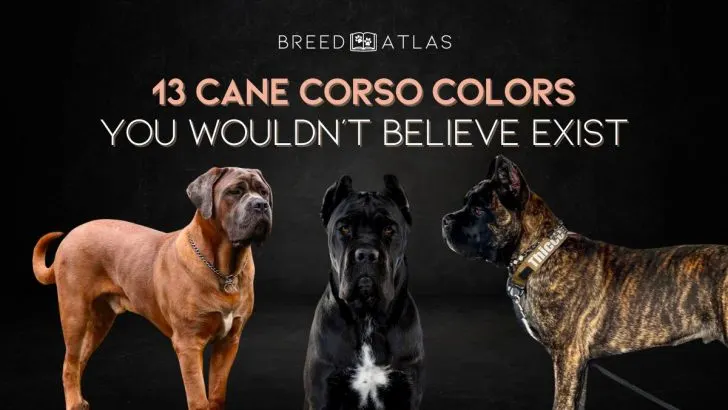Cane Corso color palette is really a magnificent sight to see. This breed has a broad scheme of hues and colors, and every one of them gives a different character to this beautiful breed of dog.
This imposing and fierce-looking dog, with their impressive size of head, extremely strong imposing appearance, and dignified demeanor, is the most loyal protector your family can wish for.
So, if you want them as a working dog or bodyguard dogs, they are going to be eager to serve you.
Well, when you weigh around 100 pounds and stand 28 inches at the shoulders, it is easy to understand why these dogs have this kind of pedigree.
This breed is one of the most favorite picks for dog owners because of their low shedding and short and stiff coat. This coat is incredibly easy to maintain, which helps a lot if you own an apartment.
These fashionable coats come in a variety of colors that are very sought after by Cane Corso lovers.
For fans of this breed, the coat color is only the cherry on top of their already remarkable physical presence that commands attention in your household.
This breed is an excellent option for those experienced with larger breeds of dogs.
Cane Corso Colors Recognized By The American Kennel Club
If you are planning to compete with your dog in conformation shows, American Kennel Club recognizes seven coat colors as acceptable colors in AKC breed standards.
Their color spectrum of the base colors spans from brindle and darker shades of fawn to mahogany, deep blue, and white.
But black Cane Corsos are the most common ones.
Let’s see what colors are accepted, shall we?
1. Black Cane Corso
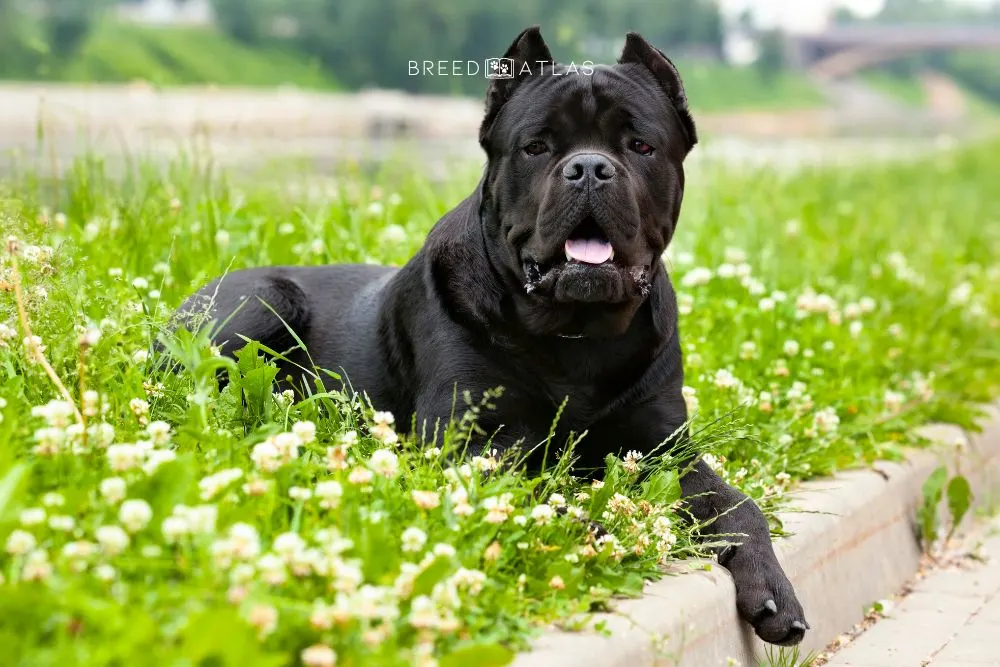
Here comes the badass black Cane Corso! This ominous-looking color fits amazingly to Cani Corsi’s already elegant and imposing aesthetics.
These are the most popular dogs if their owners are looking for guard dogs that will strike fear into the bones of uninvited people on the property.
This color is a dominant gene, so if either a male or a female is black, the color will prevail in the gene pool.
Black Cane Corso can also have white spots or streaks on their coat. In the competition environment, white patches are tolerated on specific parts of the body, such as the chest or muzzle.
But since most of us just want a best friend and member of the family, these rules are not important.
2. Black Brindle Cane Corso

These dogs are black Cane Corso’s grunge brothers. The only difference is red or brown brindle patches coming through the black coat.
This color of Cane Corso is sought after by hunters because of its better camo effect in the woods environment.
3. Gray Cane Corso

Say hi to this incredibly handsome fella, gray Cane Corso. Gray fits Cane Corso because it gives an elegant feel to their strong muscular appearance.
The light hits their coat in an interesting way, emphasizing their muscular body and making them look like a Greek god!
This alluring color jackpot comes from two recessive black genes of both parents combined in a diluted phenotype. Because of the interesting way genetics must combine, this color is rarer than most on this list.
The color changes in some individuals with age. Depending on the way that genetics did their thing, older dogs can go brighter or darker, with some developing brindle streaks, too.
Gray Cani Corsi are also very popular, but because of the genetics involved, they are rarer. If you are a competition owner, this can be very important information for you to know.
4. Gray Brindle Cane Corso
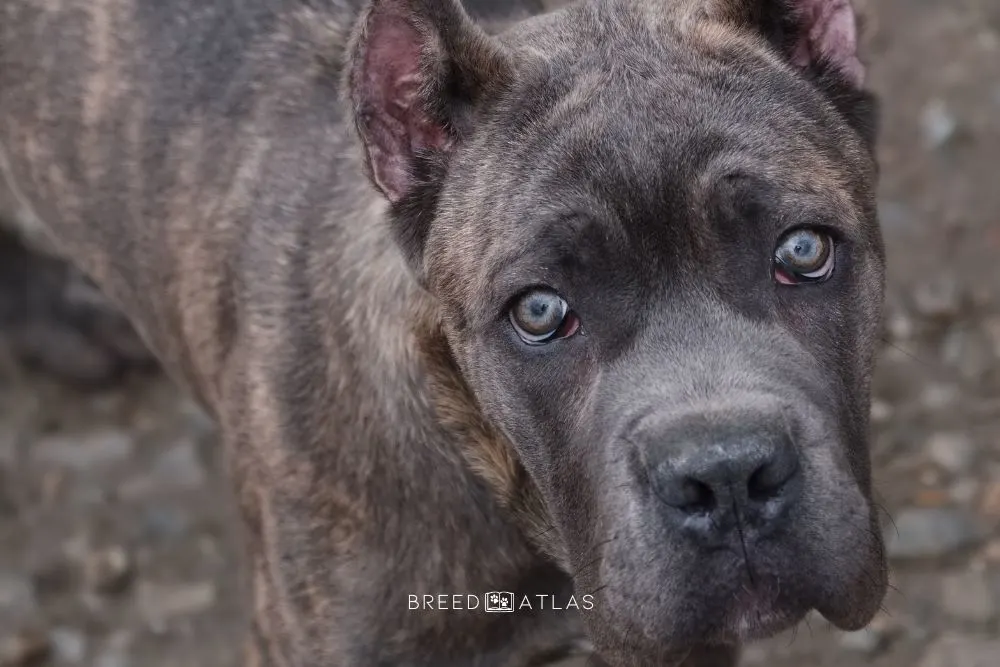
Speaking of brindles, a gray one is the rarest kind of brindle you can see in Cane Corso.
To develop this color, along with a couple of recessive genes that we talked about above, the brindle gene must also be present.
The base color is on the spectrum between brown and red hues, and gray brindle patches are sprinkled over these colors on the coat. But there is a catch!
If the dog has a black mask, then it is not an authentic gray brindle but is secondary to other brindle colors.
And yes, hunters also love this color for its camo qualities and advantages.
5. Red Cane Corso

Red Cane Corso is second to black Corso on the popularity list. Red Canes are interesting because of the wide variability of their colors.
The red color gene is a dominant one similar to the black gene, and it prevails in a way where if either of the parents has a red gene, that one will be the end result of the color of the coat of the Cane Corso puppy.
Also, black or darker gray saddle patches sometimes happen, but this is more often in younger ages Corsos, and they outgrow these patches soon.
Since there is such a wide variability of red hues in this color group, some red Corsos can be mistaken for fawn Cane Corsos. We will talk about the distinction between these two below.
6. Fawn Cane Corso
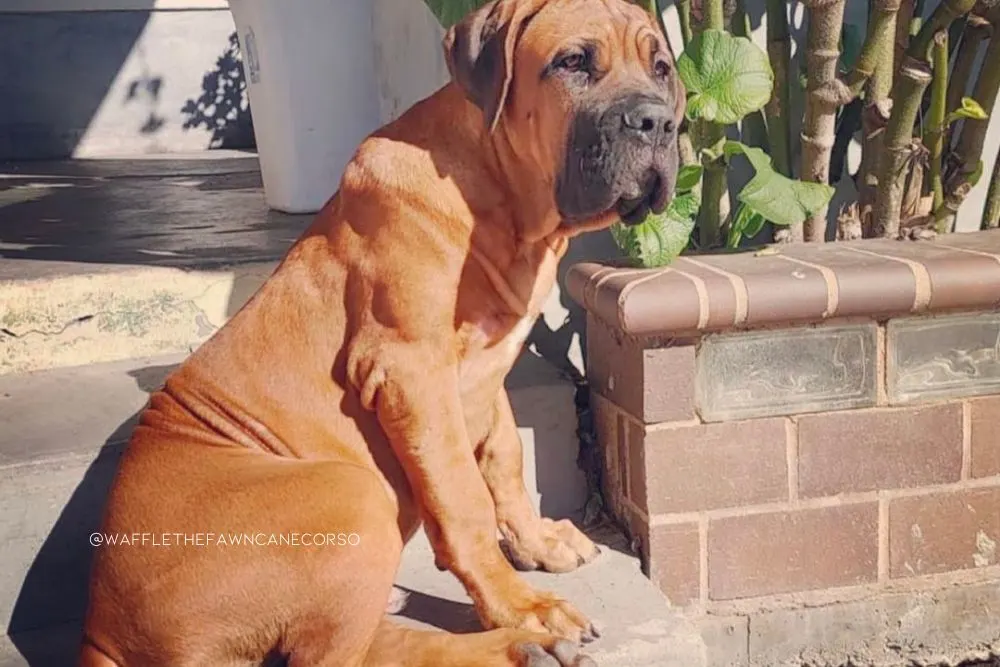
What separates Fawn Cane Corsos from their red counterparts is the diluted red gene pigment. Dilution of this gene is similar to gray Corsos in that both have to display a diluted red gene for a puppy to be born with a fawn color.
While gray dilution is rare, fawn dilution is the most common and popular, not only as diluted genes but as color in general.
When it comes to masks, fawn Corsos have gray and black masks, just like red Corsos.
7. Chestnut Brindle Cane Corso
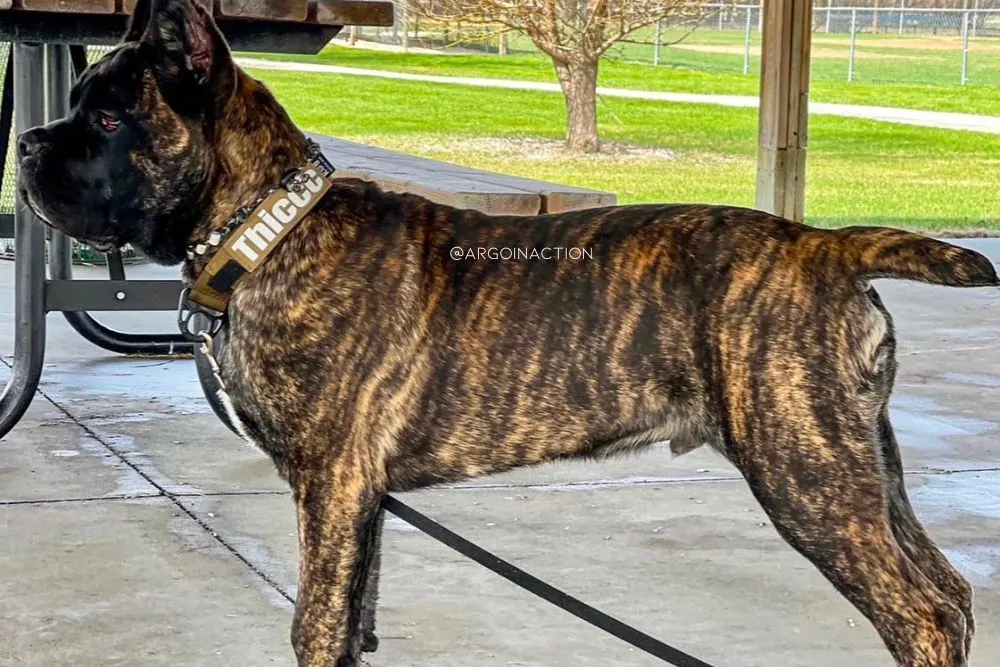
It is time to add another one of the rare colors that Corsos can display. Chestnut Brindle Cane Corso is often confused with black brindles, but on close inspection, you can see the difference.
I know that to regular dog owners, this seems like a zebra question: “Is it black and white or the other way around?” But to owners who are regular competitors in dog shows, this distinction is very important.
While chestnut brindle dogs have a red and brown combination of brindle pattern patches, black brindles have much darker patches.
The base color of the coat is red and brown, too, but on the much lighter side than brindle.
Colors Not Recognized By The American Kennel Club
There are 6 more alternative colors that are not officially recognized by the American Kennel Club approved list for competitions. The reason for this lack of recognition is the unfortunate genetic conditions that follow these colors.
Even though some breeders still breed these colors, this is not considered ethical because of the said conditions. Health is a priority to all of the dogs, as well as these.
You can recognize these colors by the blue and yellow eyes that Corsos will exhibit.
These colors can also be more expensive because they are rarer in Cane Corso than officially recognized ones.
1. Formentino Cane Corso

Formentino Corsos are continuations of diluted fawn genes. They are lighter than their fawn counterparts and display a light cream, almost sand color.
The eyes are also a giveaway for their golden or yellowish tint.
Another detail is white patches that can be seen on Corso’s chest, feet, or muzzle.
Even though these are beautiful creatures, they can also have a predisposition for Color Dilution Alopecia genetic condition.
2. Liver/Chocolate Cane Corso

Chocolate, also known as liver Cane Corso, has a deep and warm brown color on their coat that everyone is amazed by when they see it in person.
But what distinguishes them from red Corsos are the light tones that they can exhibit.
Some pinkish colors can be seen around the eyes, nose, and lips, and the color of the eyes is light hazel.
But even though these are the features that make them pretty, all this is also their curse. This color predisposes them to possible genetic diseases.
3. Blue Cane Corso
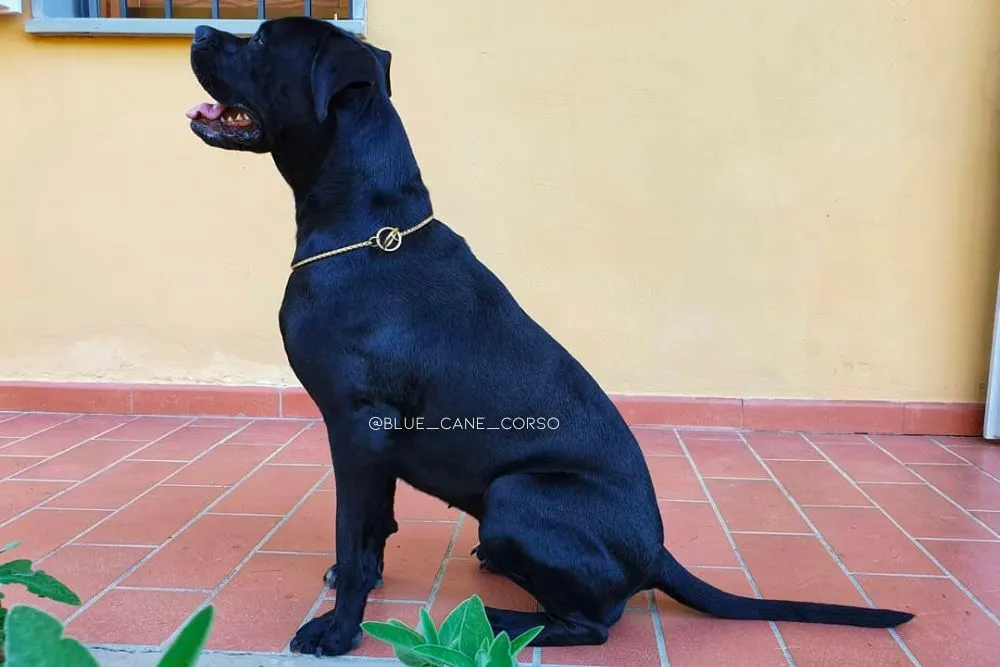
Yes, you read that well. There are blue Cane Corsos, but not in the way you are imagining it right now. Canes of this color are very similar to gray-colored Corsos.
Blue color even dilutes from the gray color gene. But to reveal authentic colors, you will need to examine them thoroughly.
Light blue undertones can be spotted around the muzzle and eyes. They also most likely have light-colored blue or yellow eyes.
Like all of the dogs on this list, they are also susceptible to diseases such as Demodectic Mange and Alopecia.
4. Isabella/Tawny Cane Corso

Isabella, also known as Tawny Color, is a very pretty version of Cane Corso, but like other dogs on this list, has many health problems.
This color comes out of the diluted version of liver or chocolate color and has many fans in the dog enthusiasts’ world.
What’s interesting about these dogs is the lilac color that can be observed on their muzzle and eyelids.
Black face masks are absent just like chocolate ones are, and have amazing green or blue eyes that hide their health problems.
But as I mentioned before, their life expectancy is rather on the shorter side.
5. Straw Cane Corso
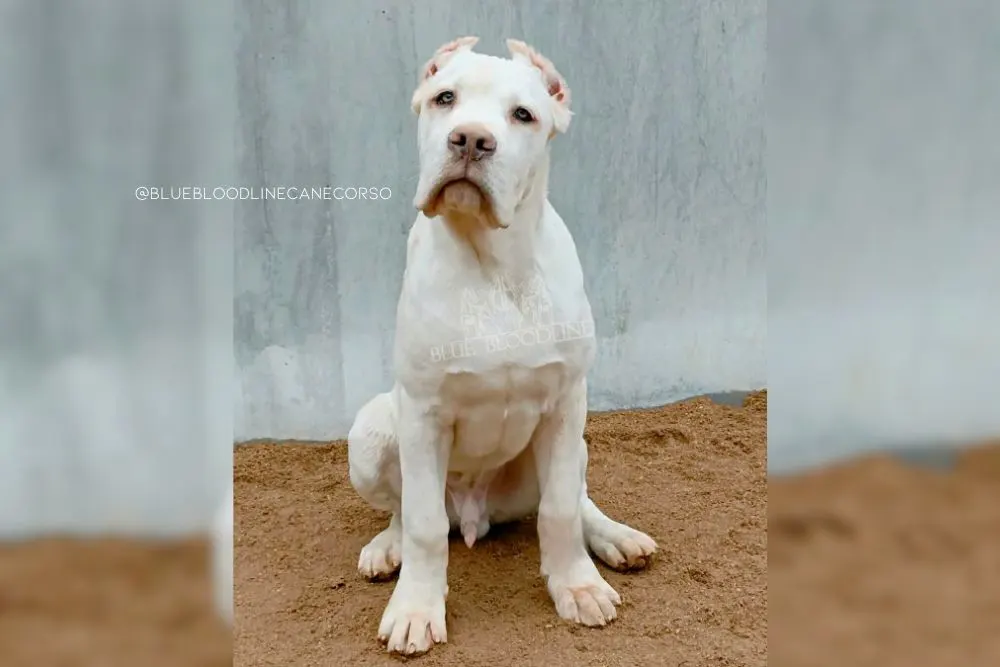
The rarity of the color on these Cane Corsos is truly remarkable.
What is interesting about these dogs is that their color is not a result of gene dilatation like other dogs on this list, but it comes from a recessive gene on its own.
Because of this difference, they are free from predispositions to genetic diseases that other light-skinned counterparts are.
Straw Cane Corsos have a variation of their white color that goes from yellowish/golden hues to white as snow color variation.
Dark colors can be present in their muzzles, shoulders, and saddle, but most of them have a pretty homogenous hue on the entirety of their coat.
6. Albino Cane Corso
Albino color, in fact, is not even a color at all, but a matter of fact, the absence of it. This phenomenon is caused by an absolute lack of melanin and pigmentation.
Albinism can occur in all of the living beings on earth actually, from plants to animals, but it is an incredibly rare occurrence which makes this “color” the rarest form of color Cane Corsos can have.
Other colors that you may see on these dogs are a very pale, bleached-out reddish pink hue around their eyes, on their muzzle, and exposed skin in general.
Do not confuse this with red eyes that are the result of some health issues or conditions that happen because of irritation.
In the eyes, there can be traces of blue reflection, although very pale and translucent.
These dogs are very sensitive to sun, where extended exposure can put them easily at risk of getting sunburn and even skin cancer.
What Is The Rarest Cane Corso Color?
There are many colors that are quite rare in the Cane Corso breed. In fact, compared to the black one, we could argue that all other colors are more challenging to find!
However, out of all the possible shades, straw seems to be the rarest one.
Many people confuse straw with white, but the exact shade of straw can vary. It usually looks more like the lightest shade of cream, although some might appear to be silvery white.
One of the issues with straw is that many of these dogs are not purebred but are, in fact, Cane Corso mixes, usually with Dogo Argentino.
Still, straw Cane Corsos do exist, although finding them can be a tough task.
Longevity Of The Different Color Dogs
Studies have shown that the coat color of Cane Corso can pretty accurately determine how long they will live. Black brindle-colored dogs are champions in this category, with approximate lives of 8 to 13 years.
Other brindle dogs also follow this pattern of longevity with a span of 7 to 11 years.
Even though they are AKC-approved, black, gray, and fawn dogs do not live as long on average as their brindle counterparts. For example, fawn dogs will live approximately 8 to 11 years.
After the diluted gene, colors will live approximately a couple of years shorter than AKC-approved counterparts.
Reason Behind Cane Corsos Large Palette of Colors
This breed has a long history that goes back to the Roman Empire where they were a favorite breed for guard dogs duty.
With the millennia of history, it is no wonder there are so many different color genes in the pool.
Does The Cane Corso’s Color Affect Its Health?
A study conducted a few years ago concluded that brindle Cane Corsos live longer than solid-colored ones.
Black brindle Cane Corsos live the longest, averaging over ten years, whereas the black and gray rarely live beyond nine years of age.
It’s also been noted that Cane Corsos with paler coats tend to be more susceptible to skin problems, whereas completely black ones are more prone to heat exhaustion.
Importance Between Color Choices
If you want to adopt a dog that will participate in shows and competitions, color choice is very important. The AKC standards are very strict about what colors they recognize as official.
Even if you have no ambitions for competing in the shows, color choice should be one thing you should consider when contemplating.
The reason for this is responsible breeders. Respectable and ethical breeders will raise healthy puppies that will have no problems in the genetics department.
Another reason is that some breeders who tend to breed alternative colors intentionally will sometimes be part of the dog fight world and act unethically towards dogs. This is why you should always demand a healthy environment and happy life for your dog.
With their strength and protective attitude, Cane Corso is a difficult breed for novice dog owners to work with. Before you get Corso, consider your dog owner experience and think if you are ready for this.
Conclusion
As you can see, the range of colors that your potential Cane Corso can have is really extensive.
Even though some colors are really interesting and beautiful to see, there is sometimes a dark background behind them.
But considering all this information, you can be sure that whichever color you choose, you and everybody around you will admire their magnificent beauty and stature.
I hope that by looking at all these variations of colors, you have understood the popularity of some and the dangers of others in terms of predisposition to genetic diseases.
If you choose colors that have unfavorable backgrounds, be aware of these conditions and own up to the responsibilities that you will have to accept to take care of them.
But all in all, you can be sure that you will get an irresistible bundle of joy, a best friend, and a life companion that will love and guard you with its whole heart.

Meet Iram, a devoted veterinarian, passionate dog lover, and current Ph.D. candidate at Utrecht University in the Netherlands. Seamlessly blending her roles as a vet and content writer, Iram channels her love for dogs into heartfelt narratives.
Since childhood, Iram nurtured a dream of becoming a vet, a passion that runs deep in her family. Having now fulfilled that dream, she’s eager to share her acquired knowledge. In her writing, Iram not only explores the emotional bond between humans and their canine friends but also integrates her veterinary expertise, offering readers a holistic understanding of their beloved pets.
